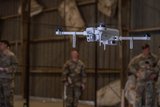ECS developing USMC simulation training system
Engineering & Computer Simulations (ECS) is developing a new training system for the US Marine Corps that utilises a Ship on Land Virtual Environment (SOLVE) to allow trainees to practice and apply their tactics, techniques and procedures in a variety of contextual situations.
The simulation incorporates a ‘slice’ of the marine's Enhanced Visit, Board, Search, Seize (E-VBSS) capabilities as an immersive simulation solution that integrates the perspectives and roles of the raid force, over watch positions and mission commander.
ECS is conducting the work under the direction of the Program Manager, Training Systems (PM TRASYS) to enable planning activities to be performed in support of mission rehearsal for the raid.
As part of this programme, ECS is delivering a realistic and accurate virtual representation of a medium sized cargo ship at sea. Marines will use the virtual ship model as the means to plan for how they will raid a vessel of that type, depending upon a variety of factors and variables that will influence their decisions and approaches.
Shane Taber, creative director and program manager, ECS, said: ‘The SOLVE will have many unique features to allow for high fidelity 3D visualisation in a portable software package, allowing it to be used as a classroom tool, familiarisation for live training, or even for mission rehearsal.’
Joe O'Connell, VP business development, ECS, added: ‘The framework for this programme establishes a capability that can be used for planning purposes for any type of maritime assets, both military and commercial. This includes commercial offshore gas & oil platforms. Whether needed for planning purposes in support of military interdiction, security training, crew familiarisation, or for crisis preparedness, the use of accurate and realistic 3D simulations enhances the process. It provides efficient and effective training to ensure our professionals are ready to face the situations they may encounter at a moment's notice.’
More from Defence Notes
-
![Canada set to look away from its neighbour and across the Atlantic for partners]()
Canada set to look away from its neighbour and across the Atlantic for partners
While non-EU UK struggles to join the Security Action for Europe initiative, which provides loans for defence programmes, Canada has become the first country outside Europe to get access – and did so for a nominal fee.
-
![NATO experiments with solutions to integrate networks, AI and uncrewed systems]()
NATO experiments with solutions to integrate networks, AI and uncrewed systems
During the latest edition of the NATO DiBaX, the alliance tested multiple capabilities to inform requirements for future efforts.
-
![Leonardo unveils plans for Michelangelo air defence dome]()
Leonardo unveils plans for Michelangelo air defence dome
The new multi-layered defence system will harness AI to neutralise airborne threats and protect Europe from Russian aggression.
-
![What will next-gen counter-UAS capabilities for the US look like?]()
What will next-gen counter-UAS capabilities for the US look like?
Future US counter-uncrewed aerial system solutions are likely to require a flexible, multi-layered approach to tackle a broad spectrum of new threats as they emerge.
-
![Elbit Systems awarded $2.3 billion contract as results soar]()
Elbit Systems awarded $2.3 billion contract as results soar
The company’s order backlog as of 30 September totalled $25.2 billion and more than a third of this is scheduled to be fulfilled before the end of 2026.
-
![US military foresees growing use of 3D printing]()
US military foresees growing use of 3D printing
Advanced manufacturing has evolved to meet military requirements and now supports multiple US critical assets, including Arleigh Burke-class destroyers, F-18, F-22, F-35, Bradley, HMMWV and Patriot.
























